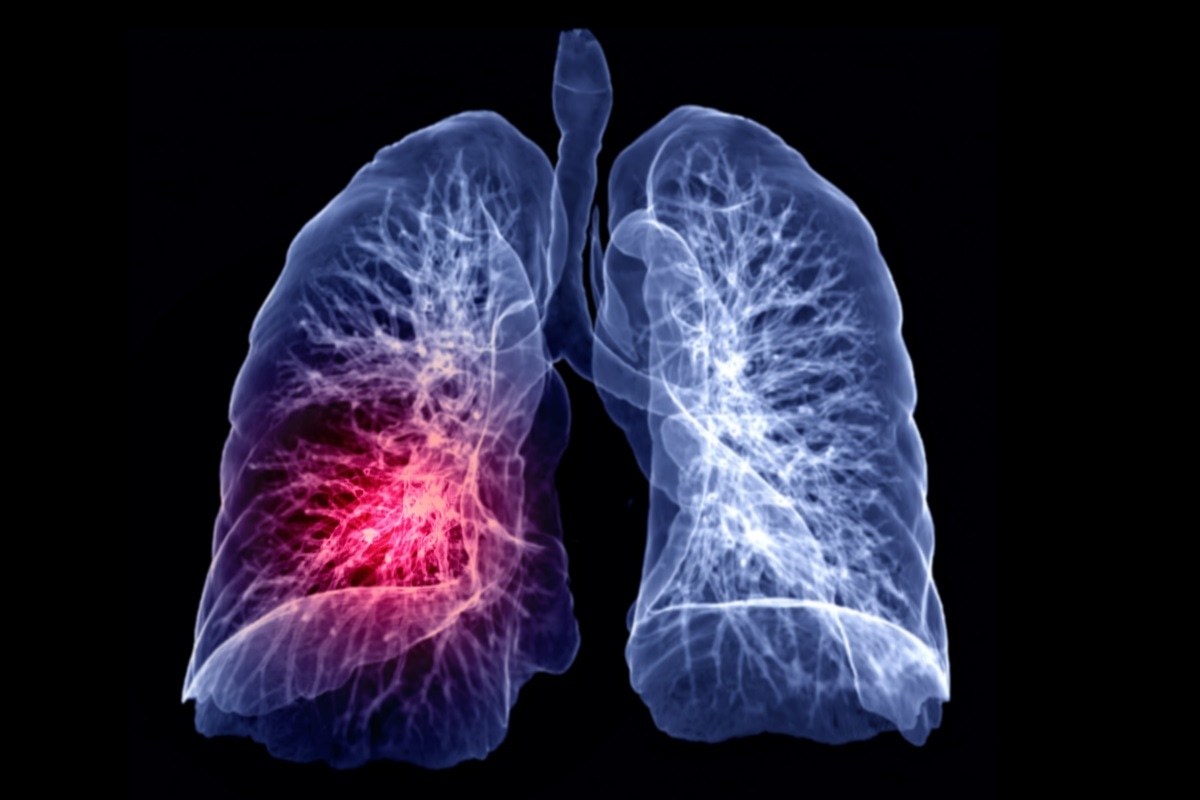COVID-19 and lung cancer have a common pathway, say researchers
The coronavirus disease 2019 (COVID-19) is a transmissible viral disease caused by the severe acute respiratory syndrome coronavirus 2 (SARS-CoV-2), the pathogen responsible for the ongoing global pandemic. The virus was first detected in Wuhan, China, at the end of 2019 and to date has caused over 109 million infections worldwide.
With over 2.4 million deaths, this virus can cause severe disease in certain high-risk groups such as those with metabolic syndrome, diabetes, cardiovascular disease and an abnormally high body mass index (BMI). A new preprint on the bioRxiv* server describes the common features shared by this condition with lung cancer.

Lung cancer
Lung cancer is the leading cause of death among all cancers globally. While smoking is the dominant risk factor, it can affect people who do not smoke as well. Recent research shows that both COVID-19 and lung cancer share common symptoms, diagnostic criteria and management.
For instance, both are more likely to occur in older people and in those with underlying medical conditions. Risk factors for COVID-19 include those with lung cancer, chronic obstructive pulmonary disease (COPD), and those being treated for cancer. Both the first and third categories may be at increased risk due to immunosuppression. The poor lung function in patients with lung cancer may vitiate the outcome of COVID-19 in this group.
SARS-CoV-2 infection
SARS-CoV-2 is known to irritate the airway mucosa, and with the progression of the disease, the infection involves the lungs. The result is severe inflammation of the alveoli and surrounding tissues, associated with fluid build-up within the lungs.
Pneumonia may be exacerbated, and the lungs fill up still more with fluid, mucus, blood and immune cells. As the immune response becomes exaggerated, the body requires more oxygen in order to produce more energy.
This is the mechanism underlying shortness of breath and the high breathing rate. The cytokine storm underlying severe and critical COVID-19 is responsible for the causing the development of acute respiratory distress syndrome (ARDS). The exaggerated levels of pro-inflammatory cytokines lead to multi-organ damage, a feature of critical disease associated with a high mortality rate.
Protein-protein interaction analysis
Viruses adapt to their preferred host, following infection by taking over the cellular machinery in order to replicate itself, produce viral proteins, and evade the cellular immune response by causing changes in the most important host cell factors. The current study used computational analysis of the interlinked activity of the host cell proteins with the viral proteins – the protein-protein interaction (PPI) data.
This was followed by gene network analysis to identify pathways of interaction. The aim was to develop new avenues for cancer therapy by identifying the hub genes that participate in the clinical course of both COVID-19 and lung cancer.
Hub genes
They identified ten hub genes, all involved in cell communication, metabolic pathways, stimulus responses and regulatory pathways. The ten essential genes were ALB, CXCL8, FGF2, IL6, INS, MMP2, MMP9, PTGS2, STAT3 and VEGFA.
The majority of them also participate in cell proliferation and development, cell organization, multicellular organism-level processes, and growth and reproduction.
With respect to the cellular component encoded, most of these genes were found to be expressed extracellularly, but also within membranous spaces and in the nucleus and endoplasmic reticulum-Golgi apparatus complex.
By molecular function, all were found to participate in protein binding, with six in ion binding. Only two genes participated in the binding of nucleic acids, antioxidant activity and hydrolase activity.
Several genes overlapping in the two conditions were found to be involved in regulating smooth muscle proliferation and cell migration and regulators of chemokines, growth factors, and other cytokine regulatory molecules.
Many of these are deeply involved in bladder cancer, diabetic complications, various signaling pathways, hepatitis B, Kaposi sarcoma-associated herpesvirus infection, and cytomegalovirus infection.
Individual functions of hub genes
C-X-C motif chemokine ligand 8 (CXCL8) is a major inflammatory response mediator, while fibroblast growth factor 2 (FGF2) is involved in limb and neurological development, cell proliferation, and tumor growth
Interleukin 6 (IL6) encodes a pro-inflammatory cytokine that induces B cell proliferation as well. Along with CXCL8, it is released at high levels during COVID-19, triggering the cytokine storm. With this pathway in common, lung cancer patients are at particularly high risk for death following SARS-CoV-2 infection.
Matrix Metallopeptidase 2 (MMP2) and MMP9 are zinc-dependent enzymes that degrade extracellular matrix components and signal transduction proteins. MMP2 is unique in being susceptible to activation on the cell membrane.
MMP-9 is markedly increased in lung diseases in which tissue remodeling is a characteristic, including asthma and COPD, or lung fibrosis. It is released by neutrophils in acute lung injury, causing swelling of the tissue and loss of alveolar-capillary barrier integrity. It also promotes inflammatory cell migration and lung tissue destruction.
As such, therapies directed specifically at this enzyme or neutrophil activation could play a key role in managing COVID-19-related lung disease. Earlier research indicates it could be an early marker of respiratory failure in these patients, which underscores the contribution of these remodeling and fibrotic processes to this outcome.
Prostaglandin-endoperoxide synthase 2 (PTGS2) is key to the prostaglandin biosynthetic pathway, probably in inflammation and cell proliferation. It was earlier suggested to be part of the mechanism by which non‐small cell lung cancer (NSCLC) arises, along with furin, a protease that, in dysregulated conditions, increases tumor growth by increasing the bioavailability of growth factors and hormones. Furin is also known to cleave the SARS-CoV-2 spike into its subunits to accomplish viral entry and infection.
Signal transducer and activator of transcription 3 (STAT3) is part of a protein family activated to its dimeric form by cytokines and growth factors. The dimers act as transcription activators within the cell nucleus. This molecule regulates many immune and inflammatory pathways and is involved in the emergence of many cancers.
During viral infection, STAT3 is hyperactive in response to viral components, as in COVID-19. This triggers the release of CXCL10, MMP9 and PAI1, from type 2 alveolar cells. PAI-1 is found at high levels in NSCLCs. A spiraling cascade of STAT3 and PAI-1 activation occurs in severe COVID-19 and is linked to very poor outcomes.
Vascular endothelial growth factor A (VEGFA) is a protein that stimulates endothelial differentiation and proliferation, causing vascular growth in both normal and abnormal situations. COVID-19 is known to be associated with high VEGFA levels in bronchoalveolar lavage fluid (BALF).
Neuropilin receptors NRP1 and NRP2 are upregulated in lung tissue, and earlier research shows that the SARS-CoV-2 spike protein uses NRP1 signaling to increase the pain mediated by VEGFA. Thus, diffuse pain could be an early symptom of COVID-19.
Albumin (ALB) encodes the most abundant plasma protein, with a multitude of essential functions. Severe COVID-19 is often linked to hypoalbuminemia. It is thought that albumin production in the liver is suppressed by the exaggerated release of inflammatory cytokines in this condition.
Low albumin thus predicts severe COVID-19 and death in hospitalized older patients. The low oncotic pressure of plasma secondary to albumin loss into the extracellular space may exacerbate the oncotic pressure in this space, aggravating ARDS.
Insulin (INS) is essential to normal energy metabolism in the body. This peptide hormone also promotes ACE2 expression via modulation of the attenuating disintegrin and metalloprotease (ADAM-17) protease.
ADAM-17 takes part in many biological functions, such as the shedding of the ACE2 ectodomain. Thus, it may compete with the TMPRSS2 protease that cleaves the ACE2 receptor within the cell. TMPRSS2 also primes the SARS-CoV-2 spike for viral entry. Inhibitors of this enzyme may thus prevent viral entry.
Conclusion
The study shows the importance of protein-protein interactions and network analysis in uncovering how proteins behave during SARS-CoV-2 infection in lung cancer patients. The ten hub genes common to both conditions were identified.
Most of these genes encode proteins intimately involved in biological pathways. This knowledge may advance the understanding of COVID-19, lung cancer, and therapies against both these conditions.
*Important Notice
bioRxiv publishes preliminary scientific reports that are not peer-reviewed and, therefore, should not be regarded as conclusive, guide clinical practice/health-related behavior, or treated as established information.
- Nan, K. S. et al. (2021). Identification of common key genes and pathways between Covid-19 and lung cancer by using protein-protein interaction network analysis. bioRxiv preprint. doi: https://doi.org/10.1101/2021.02.16.431364, https://www.biorxiv.org/content/10.1101/2021.02.16.431364v1
Posted in: Medical Science News | Medical Research News | Disease/Infection News | Healthcare News
Tags: ACE2, Acute Respiratory Distress Syndrome, Albumin, Antioxidant, Asthma, Bladder, Bladder Cancer, Blood, Body Mass Index, Breathing, Cancer, Cancer Therapy, Cardiovascular Disease, Cell, Cell Membrane, Cell Migration, Cell Nucleus, Cell Proliferation, Chemokine, Chemokines, Chronic, Chronic Obstructive Pulmonary Disease, Coronavirus, Coronavirus Disease COVID-19, Cytokine, Cytokines, Cytomegalovirus, Cytomegalovirus Infection, Diabetes, Diagnostic, Enzyme, Fibroblast, Fibrosis, Gene, Genes, Golgi Apparatus, Growth Factor, Hepatitis B, Hormone, Immune Response, Immunosuppression, Inflammation, Insulin, Ion, Ligand, Liver, Lung Cancer, Lung Disease, Lungs, Metabolic Syndrome, Metabolism, Molecule, Mortality, Muscle, Neutrophils, Oxygen, Pain, Pandemic, Pathogen, Peptide Hormone, Pneumonia, Proliferation, Protein, Receptor, Reproduction, Research, Respiratory, Sarcoma, SARS, SARS-CoV-2, Severe Acute Respiratory, Severe Acute Respiratory Syndrome, Small Cell Lung Cancer, Smoking, Spike Protein, Syndrome, Transcription, Tumor, Vascular, Viral Disease, Virus, Zinc

Written by
Dr. Liji Thomas
Dr. Liji Thomas is an OB-GYN, who graduated from the Government Medical College, University of Calicut, Kerala, in 2001. Liji practiced as a full-time consultant in obstetrics/gynecology in a private hospital for a few years following her graduation. She has counseled hundreds of patients facing issues from pregnancy-related problems and infertility, and has been in charge of over 2,000 deliveries, striving always to achieve a normal delivery rather than operative.
Source: Read Full Article


